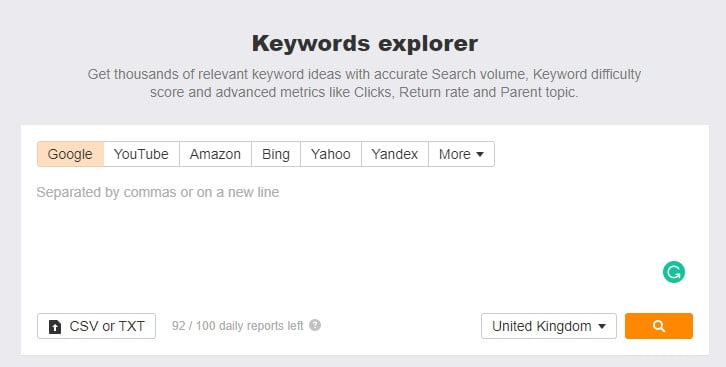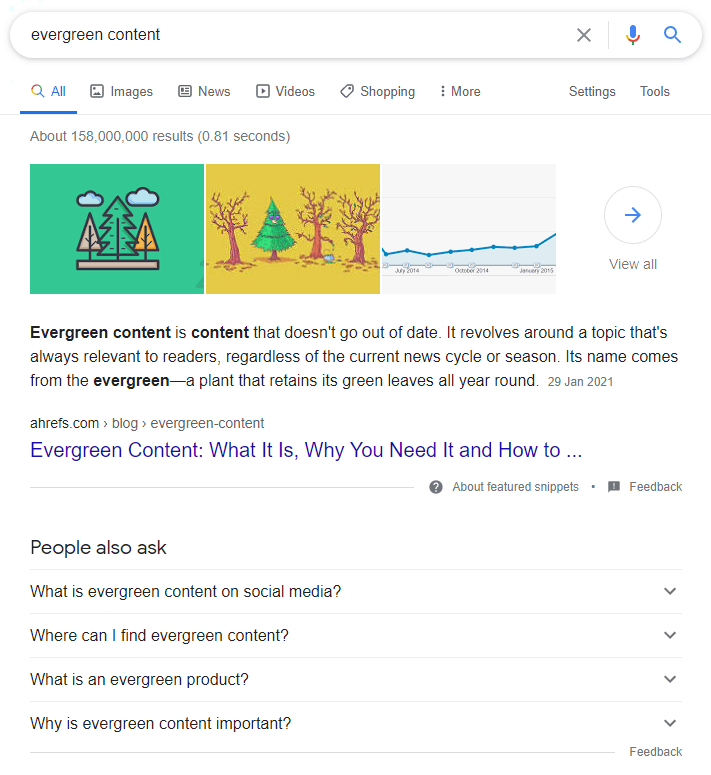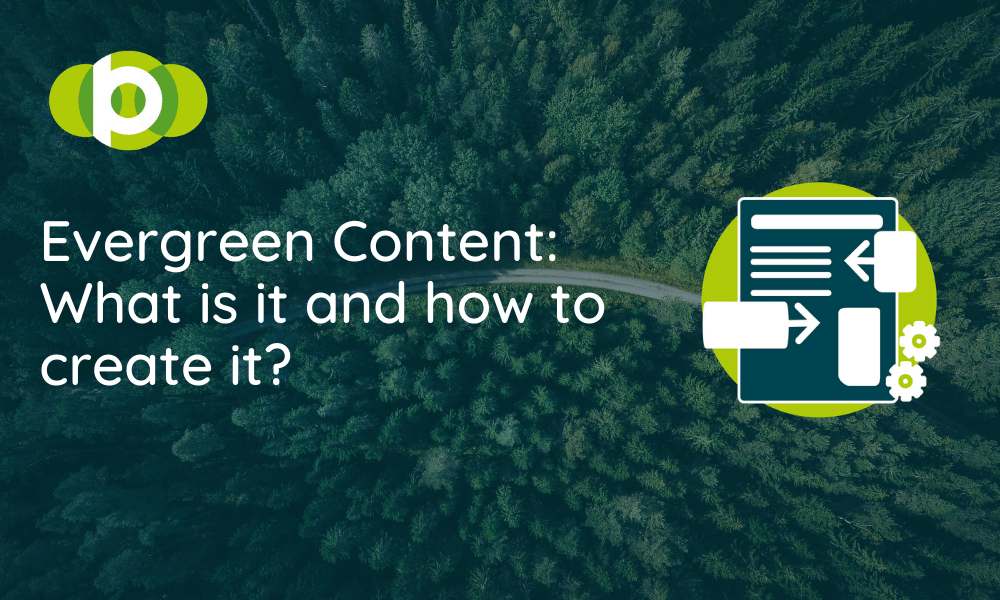If you’ve ever sat in a meeting with a bunch of marketers you’ve probably heard them say something like…
“How do we make it evergreen?”
It’s kind of the content marketers equivalent of “can you make this go viral?”
But what exactly is evergreen content and how do you go about creating it?
Well, you’re in luck because we’ve pulled together this handy guide that will walk you through exactly that.
What is evergreen content for SEO?
Evergreen content is search-optimised content that retains relevance over time, and in turn, drives and sustains traffic in the long-term.
This basically means that one-off, time-sensitive, ‘trending’ topics just don’t make the cut. But topics that are constantly searched for do.
If that doesn’t help, then as a rough guide, you can use the below checklist to figure out whether it’s likely to be evergreen or not:

Why is Evergreen content important?
Evergreen content is important as it delivers regular traffic and leads over time.
A good piece will deliver the following benefits:
Evergreen Content Benefits
It has an ROI that improves over time – Think about it. If you make a piece of content and its impact is restricted to that particular campaign, then the return on the time and effort invested in it is limited. But if it’s evergreen and getting a steady stream of traffic and leads, it is one of the few pieces of content with an ROI that actually improves over time.
It is a piece that can be promoted, recycled and respun – If your content is truly evergreen then it should be based around a topic or subject that never goes away in your industry. And that means that it can consistently play a part in your content strategy every year. You can take it and create a tweet from it. You can do live videos based on it. You can constantly reseed it and promote it in any way shape and form you see fit.
It can become a link magnet – The goal of a lot of evergreen content is to become a resource. And resources are cited and linked to constantly. Really good pieces of content that stand the test of time end up becoming as useful for link acquisition as they are for traffic.
It should free up time for other activity – If your content strategy is built on a foundation of solid evergreen content then there is less pressure to produce loads of new stuff to generate traffic. Which in theory, should free you up to do the cool, fun stuff that every marketer wants to do.
Examples of Evergreen content
The format of the post does not guarantee that it will be evergreen. However, there are some that lend themselves better to it.
Below are formats that are typically classed as evergreen content:
How-to guides
A ‘How-to’ guide will continually stay relevant as long as the problem it solves is still relevant. For example, a guide on ‘How to bake a cake’ is never going to go away. People will always want to bake cakes and at some point, people have to learn how to.
Examples
https://ahrefs.com/blog/keyword-research/
Beginner’s guides / Buyer’s guides
A beginners or buyers guide is just a twist on a ‘how to’. Whenever someone does a task or buys something for the first time they need a bit of a steer on what to look out for. So as long as the product or task stays popular it will stay evergreen.
Examples
https://www.james-porter.co.uk/ring-size-guide
https://www.carwow.co.uk/guides
https://www.quicksprout.com/the-beginners-guide-to-online-marketing/
Case studies
Case studies are perfect for producing long-lasting content. As long as the topic stays relevant and up to date, a case study can provide lasting value in the long term.
Examples
https://moz.com/case-studies/gpo
https://backlinko.com/skyscraper-technique-2-0
List posts
List posts or ‘Listicles’ are some of the most popular forms of blog content. And done well they can drive plenty of traffic to the site. The list posts that typically work well from a search perspective, are usually based around people looking for actionable tips or inspiration.
Examples
https://blog.hubspot.com/marketing/examples-of-influencer-marketing-campaigns
https://www.recycle-more.co.uk/household/recycling-facts
https://optinmonster.com/50-blog-post-ideas-that-you-can-write-about-today/
https://www.bhg.com/crafts/sewing/accessories/easy-sewing-projects/
Checklists
Potentially the most popular form of ‘Evergreen’ content. Checklists are perfect because they are a resource that people can return to over and over again.
Examples
https://www.forbes.com/sites/johnrampton/2017/11/08/a-10-point-checklist-for-writing-a-killer-blog-post/?sh=7868b22b4897
https://www.pdsa.org.uk/taking-care-of-your-pet/looking-after-your-pet/puppies-dogs/new-puppy-checklist
https://www.postoffice.co.uk/travel-insurance/skiing-packing-checklist
Tools and calculators
This type of content works for several reasons, but the most important is that it solves the user’s problem. A great example of this type of content is a mortgage calculator as it can quickly help someone to get a price without all the effort of going to a ban.
Examples
https://www.tescobank.com/loans/loan-calculator/
https://technicalseo.com/tools/hreflang/
Reviews
Reviews can be evergreen content as long as the thing that’s being reviewed stays popular. So take a film review on something like “Tenet” for example, people will likely revisit reviews after watching that film to figure out how they felt about it or just to try and work out what was going on.
Examples
https://www.autotrader.co.uk/content/car-reviews/audi-a4-review-saloon-2015
A quick guide to producing evergreen content
Now that we know what evergreen content is and its importance, we need to understand how we can create it.
Below is a step-by-step guide to creating evergreen content.
Step 1 – Understand what is currently working for you
The first step should be to understand what content is working for your audience/customers and build on it.
Using the Google Analytics organic landing page report you should be able to see:
- The highest performing posts
- The common themes and topics they’re based around
- Which formats are working well
Then the next step is to ask whether you can scale this for a quick win.

Step 2 – Look at Upcycling poorly performing content
Once you have identified poorly performing content, and why the competition is outranking us, you can look at upcycling poorly performing content.
Upcycling historic content will be much more time-efficient than writing brand new content.
To do this you need to look at the underperforming posts and ask:
- Is there interest in this?
- Is this just not working because it’s poorly executed?
- Can I add value to this?
- Could I consolidate some of these posts into one giant resource?
If the answer is yes to any of those questions above, then it is worth considering updating that piece of content.
Step 3 – Find New Content Ideas
The next step is looking for fresh content ideas.
Most people will be trying to create Evergreen Content, so there’s a high chance that the really popular topics have been covered hundreds of times.
So, you should aim to find niche content ideas that are relevant and that you have a reasonable chance of ranking for.
A good starting point to do this is to:
- Brainstorm a list of topics and terminology used in your vertical
- Take that broad list of terms and plug them into your keyword research tool of choice
- Filter them by competition level
- Group the terms by overarching topic or theme
- Start looking at what content is ranking for those terms and see what formats work best
That’s just the shortened version but if you want the longer read, here is a post that walks you through how to do Keyword Research.
https://www.broadplace.com/blog/an-apprentices-guide-to-keyword-research-for-seo-3/
Another tactic you could use for fresh ideas is to mine any relevant communities online.
These could be facebooks groups, subreddits, Mumsnet or any other type of forum or place that your audience hangs out online.
All you’re looking out for are posts that get a lot of engagement. Or a lot of posts about the same issue.
If you see both of these, you are usually onto a winner.

Step 4 – Check what’s ranking
Once you’ve got a list of ideas from your site, as well as a list of new ideas, you need to take a look at what the competition is doing.
This means taking a look at what is already ranking for that idea.
So you need to visit the SERPs, look at what is appearing and ask yourself:
- What formats are working?
- How they’ve structured their content?
- How much depth have they gone into on the topic?
- Do they promote it regularly?

Step 5 – Think about how you improve on what already exists
Once you know what the competition is doing you need to try to think of ways that you can make the content better.
Here are some quick ways in which you can make your content better:
Cover the topic in-depth – Think about if you can go deeper and further on the topic. This will help to separate it from the competition and make your post more authoritative.
Visuals – Adding a visual element to the post makes it more enticing to the reader. A picture speaks a thousand words and all that.
Make the content digestible – Particularly for complex topics, making the content easy to understand for the reader is a great way to improve it. If it is heavy on numbers and statistics, think about the narrative that you can draw from the data and what it will mean to the reader.
Conduct your own research – If you can update or add value to it with your own research then your post automatically becomes more authoritative. It’s also more likely to attract links and is harder for the competition to replicate.
Expert opinion – Leveraging the opinion of an expert can really help validate the information you are presenting and add trust to the site. This will be particularly important in more sensitive industries such as the medical or financial sectors.
Step 6 – Write for your audience
Knowing your audience is crucial.
The language you use needs to match your audience. This means that if you’re in a really technical industry then it’s okay to use technical language. Or if you’re writing something for a beginner, then you probably don’t want to use it.
You also need to understand what they are looking for from this post and what do they need answering.
If you can do the above two things then you’re not going too far wrong.
Step 7 – Don’t forget the basics of SEO
When writing your evergreen content piece, as with any page on your site, you should make sure the SEO fundamentals are in place.
Make sure you’ve got:
- An optimised title with a keyword in it
- The page is well structured with headings
- Headings are properly formatted with H tags
- Link to related posts in the copy
- Alt-text is used on images
Once these boxes are ticked, you are ready to publish!
Step 8 – Look for opportunities to tie in a related topic
Creating a content hub can be an effective way to target higher volume and more competitive keywords. This can be achieved by creating or curating several different blog posts together to answer one overarching topic. Content hubs consist of;
- Pillar content page – a high-level guide about a broad topic.
- Cluster content -in-depth guides about particular parts of the overarching topic.
Step 9 – Don’t forget to promote it
The process doesn’t just stop after publishing it. You’ve put all this effort in, you need to make sure people see it.
And that means you need to promote it.
So think about the channels you have at your disposal and how it might work across them. Ask whether:
- Can you reach out to other resource pages to link to it?
- Can you use your mailing list to promote it?
- Can you repurpose it someway for social?
Step 10 – Measuring success
Rank tracking software is very useful for keeping on top of the visibility of your post.
When you first publish the post, you can use these tools to track the visibility as the page begins to rank.
As the page ranks for a longer period of time, these tools can notify you when the page loses visibility.
A drop in the ranking of the post is a sign that the content is losing relevance.
All topics will change at some point or another, so it is important to move quickly when the evergreen status of the post runs out.
Keep an eye on the keyword rankings of the post and the amount of organic traffic that it is acquiring.
Step 11 – Update your evergreen content regularly
Just because your content is considered ‘Evergreen’ that doesn’t mean that it won’t require updates and tweaking over time.
No matter the subject, it’s pretty much inevitable that eventually, something in your content will become out-of-date. That’s why it’s important to review your content.
By updating and refreshing your content, not only will it stay up to date and accurate, but it also gives you the ability to reshare. What’s more, updating content with new findings and sources can potentially boost your SEO rankings.
Make sure you monitor the traffic of your previous blog content to check if this has dropped over time, if this is the case, then your post may be less relevant than first produced and might benefit from an update.
In Summary
If implemented correctly, evergreen content can drive valuable traffic to your site over a long period of time. Using this guide, you can create content that your users will find useful and often return to. This means a higher number of users on your website and into the top of your sales funnel. It is also a great way of building authoritative links to your site and strengthening your visibility in organic search.

